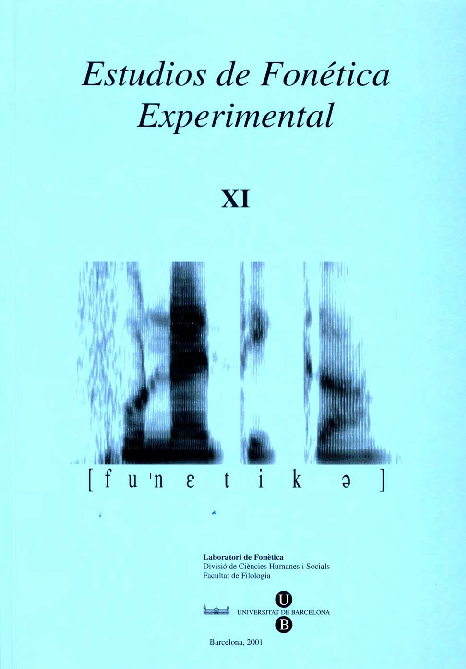Anàlisi acústica de la resolució de xocs accentuals en català
Abstract
This study aims at examining the production process of two syllables in a clash context and at describing the stress clash resolution strategies used in Catalan. First, we carried out a perception experiment (500 target sentences) which proved a high level of confusion between stressed syllables in a clash environment and unstressed syllables (camí net vs. caminet): this demonstrates the systematic destressing of the first syllable in the clash. Secondly, a production experiment was carried out with groups of three sentences (576 utterances) in which always the same syllable was compared (pi, vi) in three different prosodic conditions: clash context (vi blanc, pi gros), stressed syllable followed by unstressed syllable (vi blanquet, pi grosset), and unstressed syllable (vinet blanc, pinet gros). The results show that duration and amplitude are not robust acoustic correlates of the perception of deaccenting; conversely, the F0 contour seems to be the main cue of destressing in such clash contexts. Summing up, this article shows that Catalan uses a general strategy in stress clash resolution, the weakening or complete deaccenting of the first stress in the clash (bon home [b O"nOm«], bon vi [b Om "bi]), and furthermore, that this strategy is directly reflected in the tonal organization of the sentence.
References
ARVANITI, A. (1994): «Acoustic features of Greek rhythmic structure», Journal of Phonetics, 22, pp. 239-268.
BARNILS, P. (1933): «Sobre la quantitat de les vocals tòniques», dins Escrits de Pere Barnils, Anuari de l’Oficina Romànica de Llengua i Literatura, VI, pp. 67-78.
BECKMAN, M.E. (1986): Stress and non-stress accent, Dordrecht, Foris Publications.
BECKMAN, M.E. i J. EDWARDS (1994): «Articulatory evidence for differentiating stress categories», dins Keating, P. (ed): Phonological Structure and Phonetic Form. Papers in Laboratory Phonology III, Cambridge, Cambridge University Press, pp. 7-33.
BECKMAN, M. E; M.G.SWORA; J.RAUSCHENBERG i K.DE JONG (1990): «Stress shift, stress clash and polysyllabic shortening in a prosodically annotated discourse», ICSLP 90 Proceedings (International Conference on Spoken Language Processing), 1, pp. 5-8.
CASPERS, J. (1994): Pitch Movements under Time Pressure, Dordrecht, ICG Printing.
FARNETANI, E. i S. KORI (1983): «Interaction of syntactic structure and rhythmical constraints on the realitzation of word prosody», Quaderni del Centro di Studio per le Ricerche di Fonetica (Padova), 2, pp. 288-318.
FARNETANI, E. i S. KORI (1986): «Effects of syllable and word structure on segmental duration Italian», Speech Communication, 5, pp. 17-34.
FARNETANI, E. i S. KORI (1990): «Rhythmic structure in Italian noun phrases: a study on vowel durations», Phonetica, 47, pp. 50-65.
FERRATER, G. (1981): Sobre el llenguatge, Barcelona, Quaderns Crema.
HAYES, B. (1995): Metrical Stress Theory: Principles and Case Studies, Chicago, University of Chicago Press.
LIBERMAN, M. i A. PRINCE (1977): «On stress and linguistic rhythm», Linguistic Inquiry, 8, p. 249-336.
MASCARÓ, J. (1983): «Apèndix I: Nivell perceptual de l’accent no principal en els compostos», dins La fonologia catalana i el cicle fonològic, Publicacions de la Universitat Autònoma, Bellaterra, pp. 197-202.
NESPOR, M. i I. VOGEL (1986): Prosodic Phonology, Dordrecht, Foris.
NESPOR, M. (1989): «On clashes and lapses», Phonology, 6, p. 69-116.
OLIVA, S. (1977): «Dos aspectes del ritme en català modern», Els Marges, 9, pp. 89-96.
OLIVA, S. (1992): La mètrica i el ritme de la prosa, Barcelona, Quaderns Crema.
OLIVA, S. i P. SERRA (1990): «Stress resolution within the phonological phrase in Catalan and Spanish», ms. Universitat de Girona.
OLIVA, S. (1992): La mètrica i el ritme de la prosa, Barcelona, Quaderns Crema.
PETERSON, G. E. i I. LEHISTE (1960): «Duration of syllable nuclei in English», Journal of the Acoustical Society of America, 32, pp. 693-703.
PRIETO, P. (en premsa): «Entonació», dins J.Solà et al. (eds.): Gramàtica del català contemporani, Barcelona, Edicions 62.
PRIETO, P. i CH. SHIH (1995): «Effects of Tonal Clash on Downstepped H* Accents in Spanish», Proceedings of EUROSPEECH’95. Fourth European Conference on Speech Communication and Technology, Vol. 2, pp. 1307-1310.
RECASENS, D. (1986): Estudis de fonètica experimental del català oriental central, Barcelona, Publicacions de l’Abadia de Montserrat.
RECASENS, D. (1991): «Timing in Catalan», Actes du XIIème Congrès International des Sciences Phonétiques, vol. 4, Ais de Provença, Provença, pp. 230-233. Universitat de Provença.
SELKIRK, L. (1984): Phonology and Syntax. The Relation between Sound and Structure, Cambridge, MA, MIT University Press.
SERRA, P. (1992-93): «De la representació de l’accent», Llengua & Literatura, 5, pp. 417-443.
SILVERMAN, K. i J. PIERREHUMBERT (1990): «The timing of prenuclear high accents in English», dins J.Kingston i M.E.Beckman (eds.): Papers in Laboratory Phonology I. Between the Grammar and Physics of Speech, Cambridge, Cambridge University Press, pp. 72-106.
Downloads
Published
How to Cite
Issue
Section
License

This work is licensed under a Creative Commons Attribution-NonCommercial-NoDerivatives 4.0 International License.
All articles published online by Estudios de Fonética Experimental are licensed under Creative Commons Attribution-NonCommercial-NoDerivs 4.0 International (CC BY-NC-ND 4.0 DEED), unless otherwise noted. Estudios de Fonética Experimental is an open access journal. Estudios de Fonética Experimental is hosted by RCUB (Revistes Científiques de la Universitat de Barcelona), powered by Open Journal Systems (OJS) software. The copyright is not transferred to the journal: authors hold the copyright and publishing rights without restrictions. The author is free to use and distribute pre and post-prints versions of his/her article. However, preprint versions are regarded as a work-in-progress version used as internal communication with the authors, and we prefer to share postprint versions.




